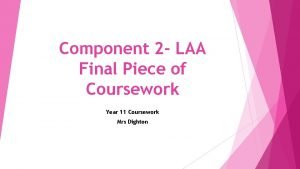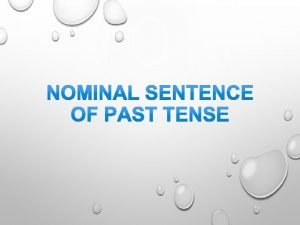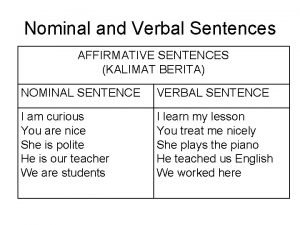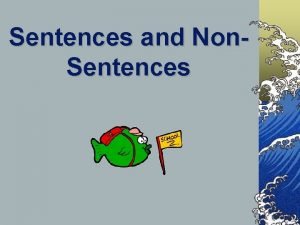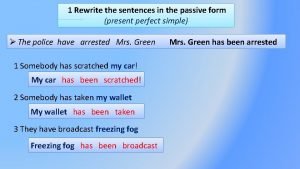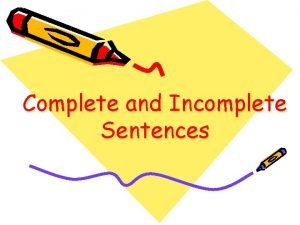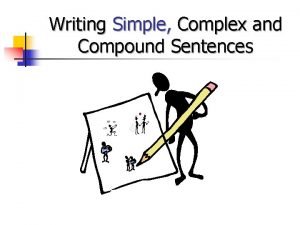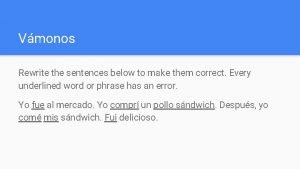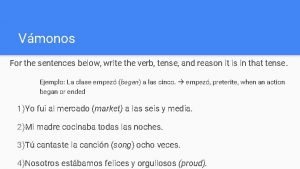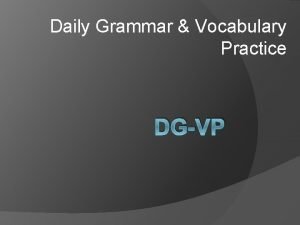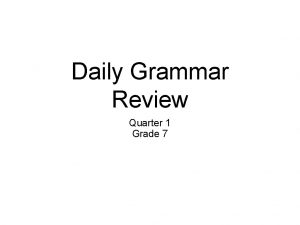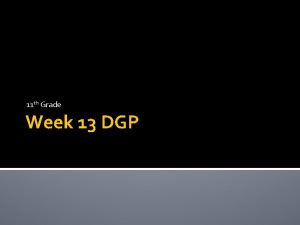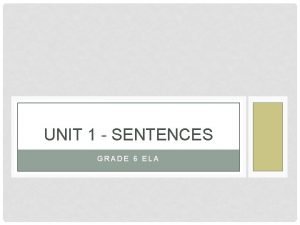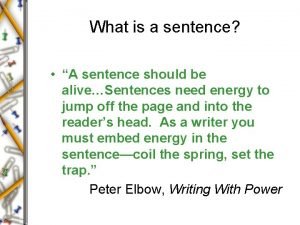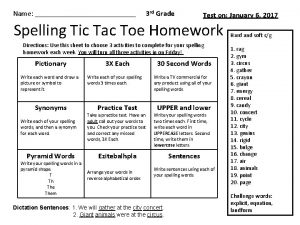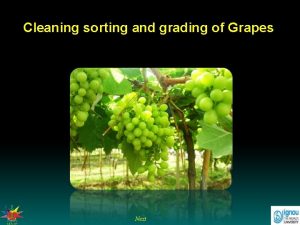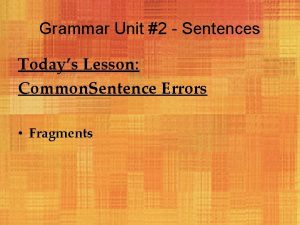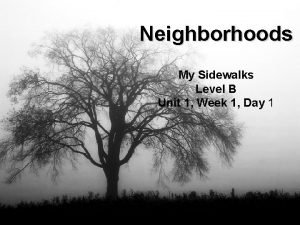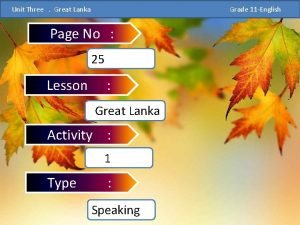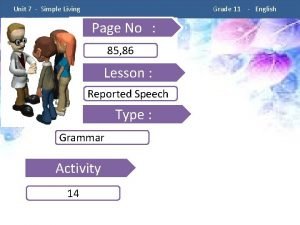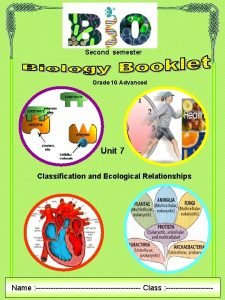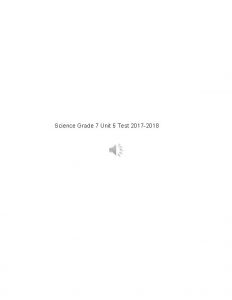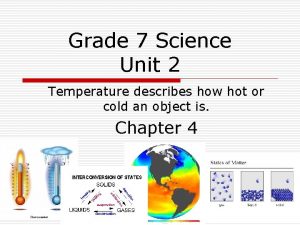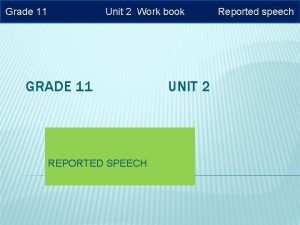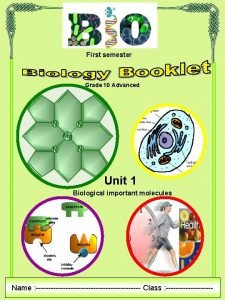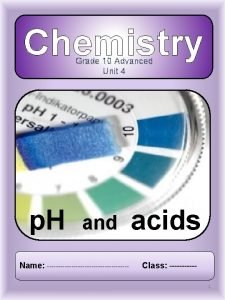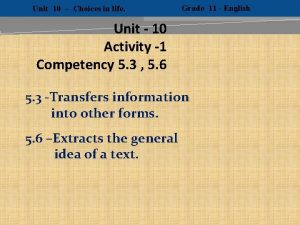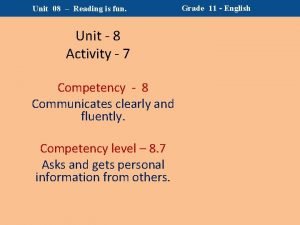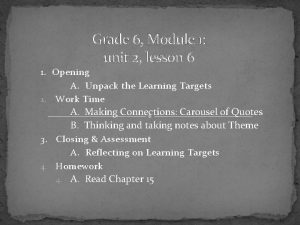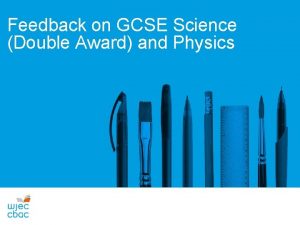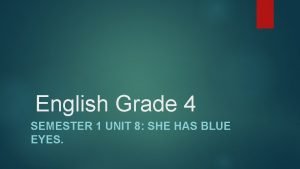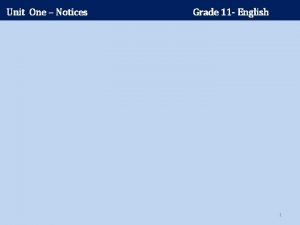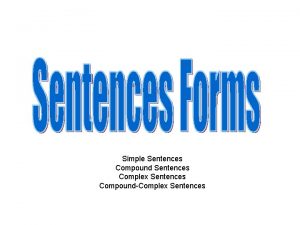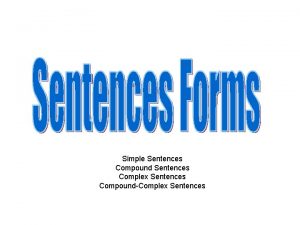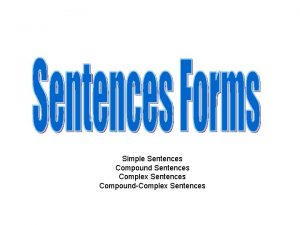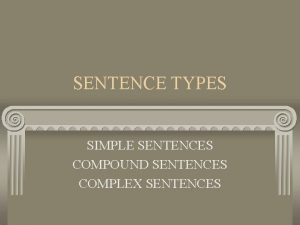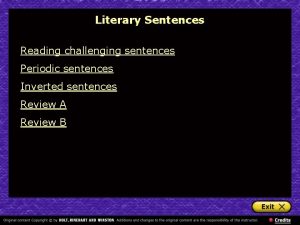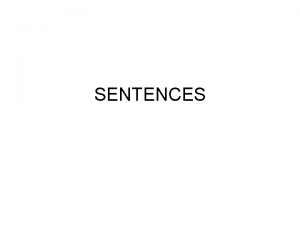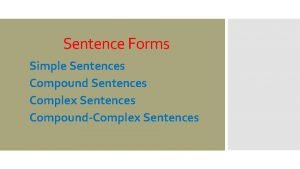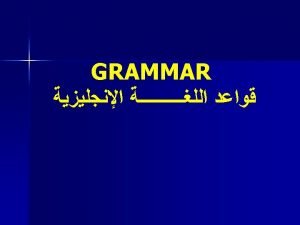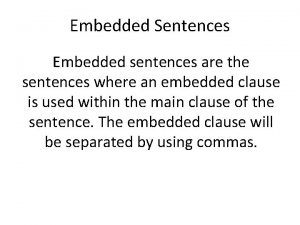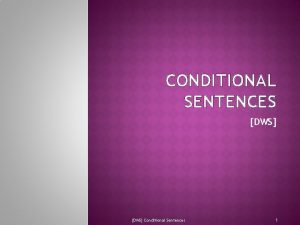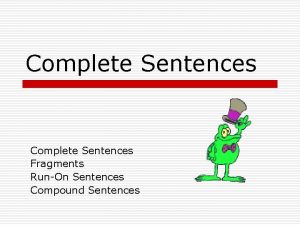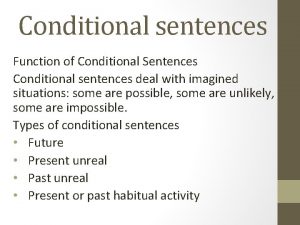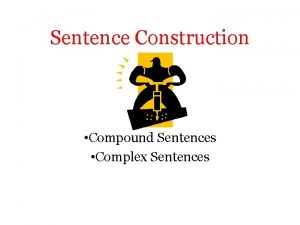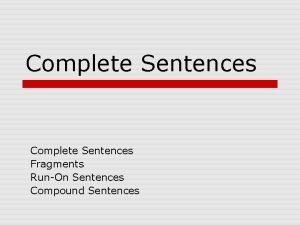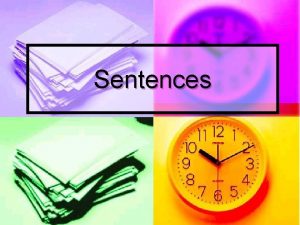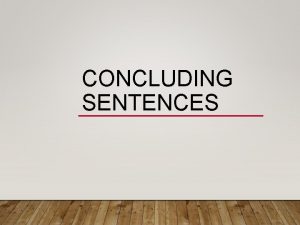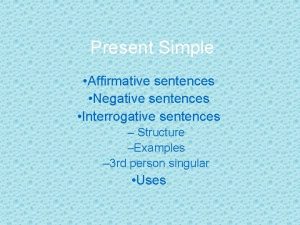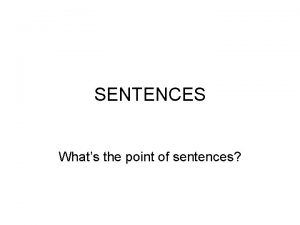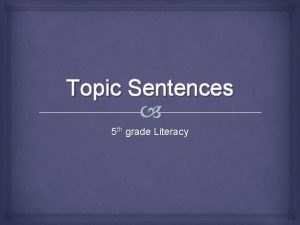Unit 1 Sentences Ms Williams 5 th Grade













































- Slides: 45

Unit 1: Sentences Ms. Williams 5 th Grade ELA

Objective I CAN identify complete sentences and sentence fragments.

Guided Notes A sentence is a group of words that expresses a complete thought. It begins with a capital letter and ends with a punctuation mark. � Example: Kelsey and Jamie listened to the thunder. �A sentence fragment is a group of words that does not express a complete thought. � Example: Listened to the thunder.

Guided Practice Tell whether each group of words is a sentence or a sentence fragment. 1. 2. 3. 4. 5. Grandmother came to visit. Brought an old family album. The two girls. Grandmother explained each picture. The girls enjoyed looking at old photographs.

Independent Practice Write sentence or sentence fragment for each group of words. Told stories about their father. Dad’s hair was black and curly. Baby pictures of Kelsey and Jamie. One picture showed Grandma playing games with the girls. 5. Jamie took new pictures of us. 1. 2. 3. 4.

Objective I CAN identify and write declarative and interrogative sentences.

Guided Notes A declarative sentence makes a statement and ends with a period. � Example: Plants produce oxygen. �An interrogative sentence asks a question and ends with a question mark. � Example: Why are plants important?

Guided Practice Tell whether each sentence is declarative or interrogative. 1. 2. 3. 4. 5. Plants are important for many reasons. Why are some plants green? Plants make food through photosynthesis. Do plants use carbon dioxide? How do plants help us to breathe?

Independent Practice Read each sentence. Then write whether the sentence is declarative or interrogative. 1. 2. 3. 4. 5. How are different plants classified? Some plants are used to make medicine. Plants need sunlight to grow. Can you name a plant used in making medicine? What are three ways plants help people?

Objective I CAN identify and write imperative and exclamatory sentences.

Guided Notes An imperative sentence tells or asks someone to do something. An imperative sentence ends with a period. � Example: Don’t go outside. � Example: Please stay in the house. � An exclamatory sentence expresses strong feeling. An exclamatory sentence ends with an exclamation mark. � Example: Oh, look at this! � Example: What a lot of noise it makes!

Guided Practice Tell whether each sentence is imperative or exclamatory. 1. 2. 3. 4. 5. Please come into the tent. Listen to the strange noise. Oh, it’s a skunk. What a terrible smell there is! How I wish we were somewhere else!

Independent Practice Read each sentence. Then write whether the sentence is imperative or exclamatory. 1. 2. 3. 4. 5. Let’s leave this place. Run for your life! Don’t be silly! Please stay calm. What a funny situation this is!

Objective I CAN learn to write compound sentences.

Guided Notes A simple sentence expresses one complete thought. � Example: July 4 is a holiday. �A compound sentence contains two simple sentences joined by a comma and the word and, but, or or. � Example: July 4 is a holiday, and everyone celebrates. �A conjunction joins words or groups of words. And, but, and or are conjunctions.

Guided Practice Tell whether each sentence is simple or compound. 1. 2. 3. 4. 5. Americans have holidays, and we honor important people. Some people celebrate the Fourth of July with picnics, but others watch parades. We watch fireworks, and we go to the park. The fireworks are bright and colorful. We can play games, or we can watch the parade.

Independent Practice Add the correct punctuation to each compound sentence. 1. 2. 3. 4. 5. The flag stands for freedom and Americans display it proudly. We sing the national anthem and we salute the flag. I march in the parade or I watch with the crowd. People eat chicken at picnics but we like pizza. I play baseball and my sister plays volleyball.

Objective I CAN correctly capitalize and punctuate simple and compound sentences.

Guided Notes �Every sentence begins with a capital letter. �Our school is having a music concert. �A declarative sentence ends with a period. �I like to sing in the choir. �An interrogative sentence ends with a question mark. �Can you play the drums? �An imperative sentence ends with a period. �Please sing loudly. �An exclamatory sentence ends with an exclamation mark. �What a wonderful song you sang! �Use a comma before and, but, or or to join two sentences. �I sing, but my brother plays the drums.

Guided Practice Directions: Tell what punctuation is missing in each sentence and use correct capitalization. Rewrite each sentence correctly. 1. listen to the rhythm of the song 2. can some students dance to the music 3. how beautiful the music sounds 4. what time does the concert begin 5. i play the bells but I don’t play the drums

Independent Practice Directions: Rewrite each sentence using correct capitalization and punctuation. 1. what music will we be playing 2. john will tap the beat on the drums 3. sing the song but don’t be shy 4. how exciting this is 5. do you sing high notes or do you prefer low notes

Objective I CAN identify the complete subjects and complete predicates of sentences.

Guided Notes Every sentence has two parts: a subject and a predicate. The complete subject contains all the words that tell WHOM or WHAT the sentence is about. o Example: The fifth-grade class went to visit the White House. The complete predicate contains all the words that tell what the subject does or is. o Example: All the students rode in a bus. A sentence must have both parts to state a complete idea.

Guided Practice Directions: Name the complete subject and the complete predicate of each sentence. 1. We learned about the three branches of government. 2. The United States Congress makes the laws. 3. The executive branch carries out the laws. 4. Judges on the Supreme Court interpret the laws. 5. Students and teachers like the Capitol Building.

Independent Practice Directions: Read each sentence. Draw one line under the complete subject and two lines under the complete predicate. 1. The Constitution created the three branches of government. 2. James Madison and other leaders wrote the Constitution. 3. The first ten amendments are the Bill of Rights. 4. Congress added the Bill of Rights in 1791. 5. The writers wanted few changes to the Constit

Objective I CAN identify simple subjects and complete subjects in sentences.

Guided Notes A simple subject is the main word or words in the complete subject. It tells exactly whom or what the sentence is about. o Example: The students like their math class.

Guided Practice Directions: Name the simple subject in each sentence. 1. My fifth-grade class studies math. 2. Math is my favorite subject. 3. Many scientists work with numbers. 4. Some numbers are very large. 5. Rocket scientists use large numbers.

Independent Practice Directions: Circle the simple subject in each sentence. 1. Our class learned about graphs. 2. A bar graph is one kind of graph. 3. Our task was to graph how many students wore red. 4. My friend Sam wore a red shirt. 5. Alexander’s socks were red.

Objective I CAN identify the simple predicates of sentences.

Guided Notes The simple predicate is the main word or words in the complete predicate. It tells exactly what the subject does or is. The simple predicate is always a verb. o Example: I like softball.

Guided Practice Directions: Underline the complete predicate, and then circle the simple predicate in each sentence. 1. My school has an annual softball game. 2. The fifth graders play against the teachers. 3. My entire school attends the game. 4. The crowd cheers for both teams. 5. The students receive the loudest cheers.

Independent Practice Directions: Underline the complete predicate in each sentence, and then circle the simple predicate. 1. The teachers wear special T-shirts. 2. The students make their own T-shirts. 3. The students and teachers choose team names. 4. The big game happened last week. 5. I pitched the entire game.

Objective I CAN combine sentences using compound subjects.

Guided Notes A compound subject has two or more simple subjects that have the same predicate. Example: Cities and suburbs are near each other. Compound subjects are joined by the word and or or. Example: Subways or trains take you home. You can combine two sentences with the same compound predicate by linking the subjects with and or or. Notice that the verb may change in the present tense. o Example: Jay likes map puzzles. Carlos likes map puzzles. o Jay and Carlos like map puzzles.

Guided Practice Directions: Name and underline the compound subject in each sentence. 1. Longitude and latitude help you locate places on a globe. 2. Mountains and valleys appear on a relief map. 3. The West or the South is the fastest-growing region of the United States. 4. Alice or Raynell lives in the Northeast. 5. Illinois and Iowa are in the Midwest.

Independent Practice Directions: Read each sentence. Underline the compound subject 1. Rachel and Kim gave a report about natural resources. 2. Encyclopedias or the Internet gave them useful information. 3. Lumber and minerals are natural resources. 4. Oil, coal, and natural gas are fossil fuels. 5. Rachel and Kim wrote the report.

Objective I CAN combine sentences using compound predicates.

Guided Notes A compound predicate has two or more simple predicates that have the same subject. Example: Emily jogs and hikes on trails. Compound predicates are joined by the word and or or. Example: Our family skis or skates in the winter. You can combine two sentences with the same subject by linking the predicates with and, but or or. Notice that the verb may change in the present tense. o Example: Jim swims near camp. Jim fishes near camp. o Jim swims and fishes near camp.

Guided Practice Directions: Name and underline the compound predicate in each sentence. 1. We shop and choose special food for our trip. 2. We pack and check our bags before leaving. 3. Liana jokes and giggles in the car. 4. Our family seeks and selects the perfect campsite. 5. We pull or carry our supplies to the campsite.

Independent Practice Directions: Read each sentence. Underline the compound predicate. 1. We kike or bicycle through the trails. 2. My mother hears and finds a rare bird. 3. We stop and notice a trail hidden by leaves. 4. My brother begs and pleads to follow the trail. 5. Our parents nod and agree to explore the path.

Objective I CAN identify and correct run-on sentences.

Guided Notes A run-on sentence joins together two or more sentences that should be written separately. Example: My science class went on a nature hike my teacher led the way. You can correct a run-on sentence by separating two complete ideas into two sentences. Example: My science class went on a nature hike. My teacher led the way. You can correct a run-on sentence by rewriting it as a compound sentence. A compound sentence has two or more simple sentences that are joined by a comma and the word and, but, or or. Example: My example class went on a nature hike, and my teacher led the way.

Guided Practice Directions: Tell which sentences are run-on sentences. 1. Mr. Simons asked us to look for wildflowers. 2. Selina found one flower Marcus found three. 3. Tricia saw poison ivy she did not touch it. 4. Some plants produce seeds inside their flowers. 5. We looked for dandelion seeds they were hard to find.

Independent Practice Directions: Write correct or run-on for each sentence. 1. Some seeds are carried through the air. 2. Butterflies pollinate some plants this helps the plant reproduce. 3. Mr. Simons pointed to a small flower. 4. A butterfly perched on a petal we saw the pollen. 5. Alberto sneezed loudly the butterfly flew away.
 Sam and verna case study answers
Sam and verna case study answers Andy williams robert williams
Andy williams robert williams Robbie williams janet williams
Robbie williams janet williams Unit 6 review questions
Unit 6 review questions Write three positive sentences of nominal sentences
Write three positive sentences of nominal sentences Nominal sentence and verbal sentence
Nominal sentence and verbal sentence Non sentences
Non sentences Retype the sentences in the passive.
Retype the sentences in the passive. Complete the incomplete sentences
Complete the incomplete sentences The cat crept through the dark house
The cat crept through the dark house Rewrite the wrong sentences
Rewrite the wrong sentences Write each of the two sentences below as one sentences
Write each of the two sentences below as one sentences Dgp week 10
Dgp week 10 Underline all the adjectives used in the reviews
Underline all the adjectives used in the reviews Dgp sentences 7th grade answers
Dgp sentences 7th grade answers Sentences
Sentences Sentences for grade 7
Sentences for grade 7 Sent interrupter ence example
Sent interrupter ence example Grade 1 dictation sentences
Grade 1 dictation sentences Ust transmutation table
Ust transmutation table Bo bo skee watan tatan origin
Bo bo skee watan tatan origin Culinary
Culinary Grades of milk
Grades of milk Grading of grapes
Grading of grapes Meta - change morph -
Meta - change morph - Unit 2 sentences answers
Unit 2 sentences answers My sidewalks level b unit 2 week 5 fluency sentences
My sidewalks level b unit 2 week 5 fluency sentences Unit 4 criminology
Unit 4 criminology Grade 11 english unit 3
Grade 11 english unit 3 English grade 11 unit 7
English grade 11 unit 7 History grade 9 unit 5
History grade 9 unit 5 History grade 10 unit 7
History grade 10 unit 7 Which of the following adaptations helps birds fly
Which of the following adaptations helps birds fly Grade 7 science unit 2
Grade 7 science unit 2 Uni 2 work
Uni 2 work Chemistry grade 11 unit 4
Chemistry grade 11 unit 4 Biology grade 10 unit 3
Biology grade 10 unit 3 Chemistry grade 10 unit 4
Chemistry grade 10 unit 4 Personal and business finance
Personal and business finance Criminology unit 4 exam
Criminology unit 4 exam Grade 11 english unit 10
Grade 11 english unit 10 Grade 11 english pupils book answers
Grade 11 english pupils book answers Eureka math grade 6 module 1 lesson 6 answer key
Eureka math grade 6 module 1 lesson 6 answer key Gcse meaning
Gcse meaning Grade 4 english unit 8
Grade 4 english unit 8 Shramadana campaign in english
Shramadana campaign in english
